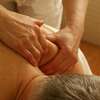What are the differences between a physiotherapist and an osteopath ?
You are a lot to ask me the difference between an osteo and a physiotherapist, here are some explanations to clarify this point.
Two distinct professions but which have the same main tool : the hands
We often confuse osteopaths and physiotherapists because of their manual practice. But behind these hands, there are two completely different and very complementary skills.
Physiotherapy

The physiotherapist uses manual methods such as massage, passive mobilization, sanding ... but also instrumental techniques such as ultrasound, shock waves, bodybuilding equipment ...
The physiotherapist's action is generally local, on the painful area or to be mobilized.
The prescriber is generally at the initiative of the location of the treatment or even the techniques to be used if specific care is required such as shock waves, ultrasound, etc.
The number of sessions is more or less depending on the support and the recovery capacity of each.
Training and recognition
Physiotherapy is a paramedical profession whose acts are governed by the Health Code.
Studies last five years including the first year of Medicine or a preparatory class. At the end of these five years they obtain a state diploma (D.E).
Subsequently, it is possible to specialize in certain areas such as sports, pediatrics or uro-gynecology.
Reimbursement
The majority of their acts are reimbursed by Social Security on medical prescription.
Osteopathy
Osteopathy is a manual therapy that takes into account the body as a whole. The osteopath has a holistic view of the human body, so he works on all structures of the body to better target points of tension.
The osteopath mainly uses manual techniques but can sometimes use simple tools such as the tape, strap or hooks.
He is a first-line practitioner which means that you do not need a medical prescription to see an osteopath. Therefore, the latter must be vigilant in the management of each patient and must be able to redirect a person if necessary.

The number of sessions is generally limited, depending on the reasons for consultation, it can range from one session to three or four. Each session is usually spaced from a week to a month depending on the reason.
Osteopathy is also very interesting in prevention.
Training and recognition
Osteopathy is a complementary medicine recognized by the Ministry of Health and Sports since 2002. Since that date, osteopathy has been regulated.
Osteopathy training takes five years and gives an osteopathic diploma (D.O) approved by the Ministry of Health (if the school is approved of course).
Subsequently, as with physiotherapists, it is possible to specialize in sports, pediatrics or obstetrics, for example.
Reimbursement
Osteopathy is not reimbursed by Social Security, but more and more mutual funds are reimbursing osteopathic procedures.
The complementarity of osteopathy and physiotherapy is a major asset for the rehabilitation of the patient
Physiotherapists and osteopaths therefore have a totally different practice, but they are complementary.
Following surgery, pathology, an accident, rehabilitation by a physiotherapist is essential. In these cases, osteopathy can intervene on an ad hoc basis to help the physiotherapist in his work by releasing areas of tension that prevent muscles or a joint from relaxing, for example.
Osteopathy is very effective in acute pain such as stiff necks and lower back pain. Physiotherapy sessions can also be prescribed to prevent the pain from becoming chronic.
The field of action of osteopathy is very wide and it is not limited to the management of spinal pain but that is not the subject of this article!
In the face of chronic pain, osteopathy is not necessarily sufficient because one or two sessions occasionally does not allow the patient to fully recover. Physiotherapy allows the patient to limit joint stiffness in order to recover muscle strength through repeated and long-term management.
The combination of these two professions is therefore a major asset in the rehabilitation of each. Not all practitioners sound like this for various reasons, but in my opinion this complementarity is fabulous for good patient care.
For any further information, do not hesitate to contact your osteopath or physiotherapist.
Magalie Quinti
Osteopath D.O in Beausoleil
Close to Monaco and Cap d'Ail